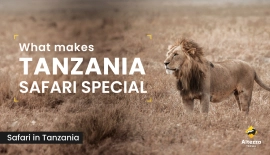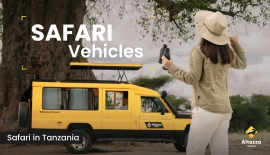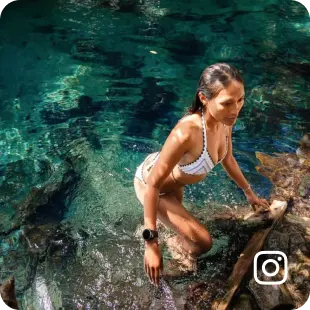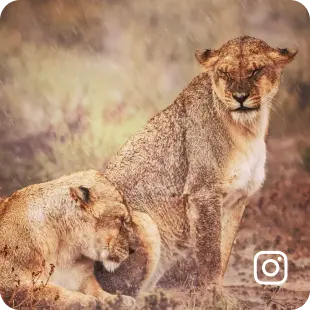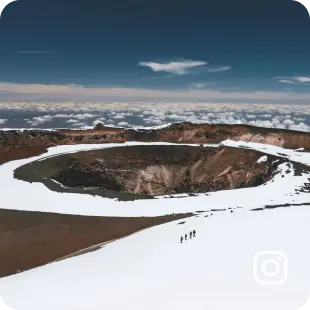
Ngorongoro Conservation Area
Ngorongoro Crater – the place with the highest concentration of animals in Africa
According to UNESCO estimates, the Ngorongoro Conservation Area is home to approximately 25,000 large mammals. Here, you can see the Big Five: elephants, rhinos, lions, leopards, and buffalo, along with other famous African animals such as hippos, zebras, antelopes, servals, and warthogs.
Most of these animals live in a compact area of 260 km² (100 mi²). On a safari drive, you will encounter new wildlife every 10-15 minutes of travel. This is one of the reasons why Ngorongoro is listed as a UNESCO World Heritage Site.
Ngorongoro is also one of the most interesting destinations in Tanzania for birders. Over 600 species of birds can be spotted here!
Where is Ngorongoro Crater located?
The Ngorongoro Conservation Area is located in northern Tanzania. It borders Serengeti to the west and Lake Manyara to the south. The city of Arusha, the main tourist hub of Tanzania, is 190 km (118 mi) away; this is about a 4-hour drive by car.
Kilimanjaro International Airport (JRO) through which most travelers enter Tanzania, is 250 km (155 mi) away.
Travelers usually visit Tarangire National Park before heading to Ngorongoro. Tarangire is closer to Arusha, making it convenient to visit on the way to Ngorongoro. After a safari in Ngorongoro, you can head to the famous Serengeti National Park. The drive takes about 3 hours, allowing you to reach your hotel by evening to rest before starting your safari the next day.
Ngorongoro Crater - part of the Conservation Area
When planning your trip, it's important to remember that the Ngorongoro Conservation Area and the Ngorongoro Crater are not the same. The total area of the Ngorongoro Conservation Area is 8,292 km² (3,202 mi²). This is about six times the size of Los Angeles and over five times the size of London.
The Ngorongoro Crater is the main attraction of the Conservation Area. It is called a "crater" due to its volcanic origins. Once, there was a massive volcano whose remaining walls formed the Ngorongoro Caldera. Contrary to popular myth, wild animals can leave its confines but rarely do so because the crater provides everything necessary for their comfortable habitation.
The crater area is only 260 km² (100 mi²). If you have one day of safari planned in Ngorongoro, you will spend most of it there.
In addition to the crater, the Ngorongoro Conservation Area has several other attractions, such as Lake Ndutu, Olduvai Gorge, Empakai, and Olmoti Craters.
Animals in the Ngorongoro Crater, Tanzania
On a Ngorongoro Crater safari, you can see the majority of the famous animals of Tanzania. Most of them do not leave the crater’s confines, and thousands of mammals inhabit the small area simultaneously. You can see practically all the main savanna inhabitants in a day.
The estimated number of large mammals in the Ngorongoro Crater in 2020 was derived from research conducted by a team of scientists that included Patricia D. Moehlman and Joseph O. Ogutu. Their study, titled "Long-term historical and projected herbivore population dynamics in Ngorongoro Crater, Tanzania," provides detailed population estimates for the crater's wildlife:
- Elephants - 300
- Lions - 55
- Black Rhinos - >30
- Spotted Hyenas - 6000
- Buffalo - 4000
- Zebras - 4000
- Wildebeest - 10,000
- Elands - > 70
- Thompson's Gazelles - 1500
The count does not include small mammals such as servals, caracals, warthogs, and foxes. The team of researchers estimates the total number of mammals in Ngorongoro to be around 25,000. This number is not constant, as animals periodically move in and out of the crater.
The Big Five in Ngorongoro Crater
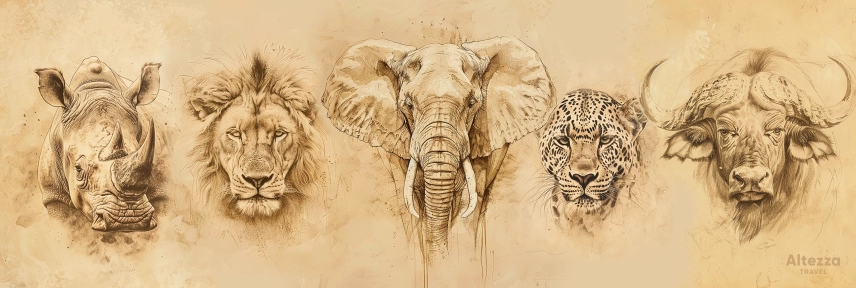
According to Philip Briggs, author of the leading guide to African countries Bradt, Ngorongoro is the best place in Africa to observe the Big Five. It has the highest density of elephants, lions, and buffalo on the continent. The chance of seeing the rarer members of the Big Five—rhinos and leopards—is also higher in Ngorongoro than in any other national park, although encounters with them do not happen on every game drive. These animals are generally rare.
Altezza Travel safari expert Agnes visits all the parks in northern Tanzania several times a year. Her trips in 2023 and 2024 confirm Briggs' opinion: in one day in Ngorongoro, you are likely to see all the Big Five animals. Only the rhinos are relatively elusive, as they prefer to stay away from traveler roads.
Agnes also notes that unlike in Tarangire and Serengeti, elephants in Ngorongoro are mostly solitary. Herds are also seen, but not with such numbers as in the neighboring national parks.
How did animals get into the Ngorongoro Crater?
Animals naturally migrated into the Ngorongoro Crater over thousands of years, attracted by its fertile environment, abundant water sources, and rich vegetation. This unique ecosystem, formed after a volcanic eruption 2-3 million years ago, provided a safe haven with enough food and protection from external threats. This allowed various species to thrive here.
Contrary to common misconception, animals can enter and exit the Ngorongoro Crater. The steep crater walls act as a boundary but do not entirely prevent movement. Wildlife occasionally migrates in and out, seeking food, water, or new territories.
When is the best time to visit Ngorongoro Crater?

In mid-January, seasonal rains result in lush grass throughout the Conservation Area. The weather is hot and clear. Herbivores—elephants, buffalo, zebras, and antelopes—graze across the Conservation Area, and you will see them almost immediately upon descending into the crater floor.
Predators such as lions and leopards are most active during the morning and evening hours, resting in the tall grass during the day. They are often seen near safari roads, unafraid of the safari vehicles.
If you are interested in birdwatching, the winter months are the best for observing birds. During this time, migratory birds arrive in Tanzania, and the diversity of species reaches its peak.
January is one of the most popular months for safaris in Ngorongoro, so be prepared for many other visitors in the Crater.
February is the warmest month in Tanzania. In the Ngorongoro Crater, daytime temperatures rise to 26°C (79°F).
On a single day of safari in Ngorongoro, you will see nearly all the famous African animals—elephants, zebras, buffalo, lions, and leopards, as well as antelopes and ostriches. In the southeastern part of the crater, there is a large colony of hippos. This wildlife area offers the highest chance to see the rarest animal in Africa—the black rhinoceros.
Since the crater area is small, animal encounters occur approximately every 15-20 minutes. This is a higher rate of sightings compared to any other national park in Africa.
February is a popular month for safaris in Ngorongoro. In the beginning and middle of the month, expect more travelers. Towards the end of February, the number of visitors begins to decrease.
In March, the weather in Ngorongoro is pleasantly warm. It is a transitional month between the dry and rainy seasons. Towards the middle of the month, the number of tourist vehicles significantly decreases, and lodges offer seasonal discounts. We recommend March for travelers who prefer a leisurely and secluded vacation.
Buffalo, elephants, zebras, lions, leopards, and other large mammals can be found throughout the crater. Additionally, on a safari in Ngorongoro, you can see almost all types of African antelopes, from large elands to tiny dik-diks.
April is considered the rainiest month in Tanzania, but there are sometimes sunny and dry days. The Ngorongoro Crater is again covered with thick grass and the landscape shifts from dry yellow hues to fresh greens. Water sources are abundant throughout the area, and animals spread across the entire crater. Due to its relatively small size, it is possible to encounter elephants, antelopes, lions, zebras, and other large mammals every 15-20 minutes of travel.
During this time, hotels on the crater rim offer the lowest prices and have fewer guests; you might see only a few other safari vehicles throughout the day. Accommodation costs are typically 1.5 to 2 times lower than in February or August.
In May, the rainy season continues in the Ngorongoro Conservation Area. Rains usually occur daily, but sometimes there are completely dry days. The savanna is covered with dense vegetation, making it difficult to see smaller inhabitants such as mongooses, serval cats, caracals, and warthogs. Large herbivores—elephants, buffalo, antelopes, and zebras—enjoy the abundant grass and move leisurely around the crater. Occasionally, you might see the rarest African mammal—the black rhinoceros.
Predators such as lions and leopards are also present in the wildlife area. They are more active in the morning and evening, preferring to rest during the day. In the southeastern part of the crater lives a large colony of hippos. They spend most of their time in the water, coming ashore in the evening to graze. Sometimes, they leave the water briefly during the day.
The forested area on the crater rim is home to many birds. One of the most striking is the Schalow's Turaco. To get a better look, use the binoculars available in every Altezza Travel safari vehicle.
As in April, there are few other travelers in the crater, and lodge prices are at their annual low.
By mid-June, the dry season returns to Ngorongoro. Unlike January and February, the summer months in Tanzania are cooler. Night temperatures can drop to 5-6°C (41-43°F). Be sure to bring a fleece jacket and a light windbreaker for safari; game drives in the crater start early in the morning and it can get chilly. You can find a complete list of what to bring in the 'Safari packing list' on our website.
Daytime temperatures are comfortable and not hot, and there are still few travelers in the crater. Early June offers the last seasonal discounts in hotels, allowing you to go on a safari at a lower cost than in July. Our safari expert Agnes believes that, like early March, June is the ideal time for a safari in Ngorongoro.
In this month, you can see all the well-known residents of the African savanna: elephants, buffalo, zebras, antelopes, and in the southeastern part of Ngorongoro, near the Ngoitokitok Springs, hippos. You can also see predators such as lions, leopards, and hyenas.
In July, the dry season continues in Tanzania. Night temperatures on the crater rim can drop to 4-6°C (39-43°F), so don't forget a fleece jacket and a light windbreaker. Safaris in the crater start at 6:30-7:00 AM, and it can be cold if you are not dressed warmly. During the day, temperatures rise to 25-30°C (77-86°F). The weather is dry and sunny, and the area will again have many other safari vehicles.
Large mammals—zebras, antelopes, buffalo, lions, and elephants—are everywhere in the crater. It is rare to drive 15-20 minutes in Ngorongoro without seeing any animals. They are accustomed to the vehicles and do not run away
The wildlife in Ngorongoro is perhaps the most abundant in Africa, and July is the best time to get to know it. The grass dries out, making it easy to spot smaller savanna inhabitants: servals, caracals, and bat-eared foxes. Ostriches and jackals are also frequently seen. You can observe almost all African antelopes in Ngorongoro: impalas, tiny dik-diks, duikers, and elands. Finally, the rarest savanna inhabitants—black rhinoceroses—are found here. You will not see this many animals on a single game drive anywhere else.
It is important to remember that the trip should not cause discomfort to the local wildlife. Please, respect the rules of Tanzania's national parks.
August is one of the driest months of the year. There is almost no rain, and the weather is sunny and pleasant every day. However, it is cool at night and early morning, with temperatures dropping to 5-7°C (41-45°F) at lodges on the crater rim. Bring a light jacket and a fleece sweater.
Descending into the crater, you will be surrounded by thousands of wild animals. In Ngorongoro, you can see the Big Five—lions, leopards, buffalo, elephants, and rhinos—as well as other savanna residents: antelopes, zebras, and hippos. This month is also great for observing small savanna inhabitants. The grass dries out, making it easy to spot warthogs, mongooses, serval cats, and caracals.
Be prepared for many other travelers in Ngorongoro in August. Sometimes, 4-5 vehicles can gather near a group of animals. If you prefer a more solitary experience, consider less crowded months such as March, June, and October.
In September, the dry season continues in Ngorongoro. As in August, be prepared for many other visitors.
Animals tend to stay near the water source at Lake Magadi, but many can also be seen in remote corners of the reserve. On a safari in Ngorongoro, you will encounter all the famous residents of the African savanna—elephants, lions, buffalo, hippos, antelopes, and zebras. It is also one of the few places in Africa where the rare black rhinoceros lives. They tend to stay away from safari roads, making sightings not always possible.
September is the peak of the dry season. There is little grass in the reserve, making it easy to observe small savanna inhabitants—mongooses, serval cats, caracals, and warthogs.
October is a transitional month between the dry winter season and the autumn rains. It is an excellent time for a safari trip to Ngorongoro. The weather is pleasantly sunny, and there are noticeably fewer visitors in the reserve than in August or September. Occasionally, there may be rain.
As in other months, animals are everywhere in Ngorongoro. You will encounter large savanna mammals—lions, buffalo, zebras, antelopes, and elephants. You can encounter hippos at Lake Magadi, a shallow soda lake in the middle of the crater. Travelers will also be able to observe lesser-known savanna inhabitants—caracals, serval cats, warthogs, and others.
In November, the warm rainy season begins in Tanzania. The number of visitors in the crater decreases, and hotels start offering seasonal discounts. This month is ideal for those who want to visit one of Africa's most famous wildlife areas in a more secluded manner. With high probability, there will be only a few dozen vehicles in the entire area, allowing you to observe the animals without being distracted by other visitors.
Due to the rains, temporary water sources appear in Ngorongoro. They spread throughout the reserve, and elephants, lions, antelopes, ostriches, and zebras can be seen almost anywhere. In the southeastern part of Ngorongoro, there is a large colony of hippos.
Small savanna inhabitants—serval cats, caracals, and warthogs—can be difficult to spot due to the rapidly growing grass from the rains.
Due to the equatorial climate, mornings and evenings in December are noticeably warmer than in June-September. The weather can be changeable, but the rains in the crater will not hinder your safari. From our Land Cruisers, you can comfortably observe the wildlife in any weather.
Waking up in a hotel on the crater rim, you will enjoy a beautiful view of the African savanna before descending down. Animal encounters in Ngorongoro occur much more frequently than in other Tanzanian national parks. In just one day, you can see all the large mammals: elephants, zebras, antelopes, and buffalo. Small savanna inhabitants—jackals, foxes, and duikers—can be hard to spot due to the tall grass, but they often come out onto the road. All animals are accustomed to the vehicles and allow close observation.
The end of December is one of the most popular periods for safaris. If you plan to visit during this time, we recommend booking your trip 4-6 months in advance.
How much does a safari in Ngorongoro cost?
Visiting the Ngorongoro Conservation Area is included in most safari tour packages in northern Tanzania. The cost of such a safari depends on several factors: the season, the choice of hotels, and the number of travelers.
On average, a safari in Ngorongoro costs $500-900 per person per day. Luxury travel options with stays in high-end hotels are also available, costing several thousand dollars per day.
What to see in the Ngorongoro Conservation Area?
Besides the main attraction—the crater with its wildlife—the Ngorongoro Conservation Area has several other interesting locations. We recommend setting aside an extra day to visit them.
Olduvai Gorge and the Leakey’s camp
Olduvai Gorge – is an excavation site where renowned anthropologists Mary and Louis Leakey found remains of ancient humans dating back 1.5-2 million years. Today, there is the Olduvai Gorge Museum displaying exact replicas of ancient tools and other artifacts found during the excavations. There is also a cafe where travelers can rest and enjoy the view of Olduvai Gorge.
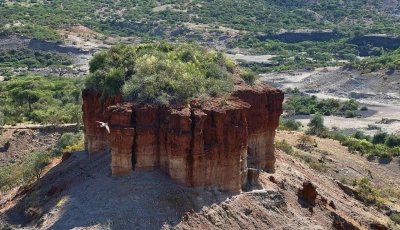
Empakai Crater
Another ancient volcanic crater, Empakai, is located north of the 'main' Ngorongoro Crater. This is one of the few places in the reserve where hiking is allowed. The rules require all visitors to be accompanied by an armed ranger. In the middle of the crater is the namesake Lake Empakai, where flamingos can be seen from November to May.
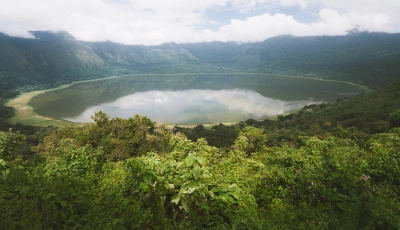
Olmoti Crater
Olmoti is another popular hiking destination in the Ngorongoro Highlands. Even in the dry season, there are rarely other visitors. This hike is perfect for travelers who want to enjoy Tanzania's nature away from the numerous safari vehicles.

Nasera Rock
Alongside Olduvai Gorge, Nasera Rock is an important archaeological site. The rock stands about 50 meters (164 ft) tall, towering over the savanna like a 16-story building. Primitive stone tools such as axes, blades, and hammers used by early humans around 300,000 years ago were found here. Based on these findings, scientists reconstruct the process of human evolutionary development.
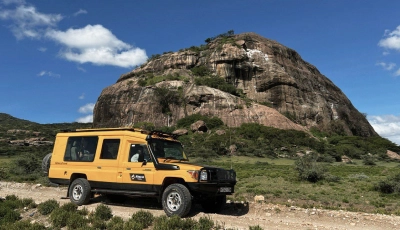
How many days do you need for Ngorongoro Crater safari?
To explore the main attraction of Ngorongoro—the crater with its wildlife—one day is sufficient. In the evening, you will arrive at a hotel on the crater rim to rest. The safari starts early in the morning and ends around 2:00-3:00 PM. By this time, an Altezza Travel safari guide will take you to a lodge.
Expert Opinion
Most visitors to Ngorongoro spend just one day on the crater floor, but Agnes, an Altezza Travel expert, believes that this short time allows only a basic introduction to its wildlife and key areas. She recommends extending the visit to two or three days if time and budget allow, to observe different animal behaviors, spot animals missed on the first day, as well as to learn more about Ngorongoro's birds.
On the second day, the safari experience might be quite different: rhinos might come closer to the roads, lions could move to more picturesque settings, and hippos might come ashore for a closer look. Planning a two to three-day visit, if possible, provides a more comprehensive understanding of the crater’s dynamics than a single-day trip.

You can visit Olduvai Gorge on the same day on your way from Ngorongoro to Serengeti.
Ngorongoro Highlands offer many interesting locations other than the main crater. If you want to visit Olmoti and Empakai Craters in addition to the main crater, you need to add another day to your Ngorongoro safari.
Airstrips in Ngorongoro

Traveling from Arusha to Ngorongoro by car typically takes about four hours. Alternatively, you can reach Ngorongoro Crater by plane in less than an hour, offering a scenic aerial view of the savanna. This flight option is particularly appealing for those looking to minimize travel time on the road.
Flights to Ngorongoro are provided by local airlines such as Coastal Aviation, Flightlink, Regional Air, and Auric Air, utilizing small aircraft that seat between 6 and 13 passengers.
The Ngorongoro Crater is serviced by two airstrips:
Ngorongoro Airstrip – named after the crater, is located on the crater rim at an altitude of about 2,300 meters (7,546 ft) above sea level near the Ngorongoro Conservation Area Headquarters and Ngorongoro Crater Lodge. Upon arrival, you can start your game drive almost immediately.
This airstrip has one drawback—constant cloud cover. Due to this, there are no regular flights, only charter flights. However, be prepared that even a charter flight might not get permission to land, and you may have to land at the nearest Manyara airstrip.
Lake Manyara Airport is located south of the Ngorongoro Crater at an altitude of 1,260 meters (4,134 ft) above sea level. It experiences much less cloud cover and receives regular flights. The airport primarily serves flights to Lake Manyara National Park but is also convenient for reaching Ngorongoro. The road from Lake Manyara airstrip takes about one and a half hours.
If you decide to reach Ngorongoro by air, Altezza Travel will help you find suitable tickets or book a charter flight. Our driver will take you to the flight, and a guide will meet you upon arrival to start your game drive in one of Africa's most interesting wildlife destinations.
Black Rhinos in the Ngorongoro Crater

According to the International Union for Conservation of Nature, the black rhinoceros is currently Critically Endangered, meaning it is on the brink of extinction in the wild. Although this status sounds alarming, Tanzania's policy for protecting these animals inspires cautious optimism.
Researcher Dr. Wilfred Odadi from Egerton University found that in the 1960s, there were about a hundred black rhinos in Ngorongoro. By the 1990s, poachers had nearly wiped out the population, with only 11 individuals surviving.
Fortunately, the country's leadership recognized the severity of the problem in time and launched several programs to restore the rhino population. Their goal is to increase the black rhino population by 5% annually. Rangers began to patrol the crater area regularly, and poaching incidents gradually declined.
Over time, the Frankfurt Zoological Society, the International Rhino Foundation, and the World Wildlife Fund (WWF) joined the project. Funds provided by these organizations ensure round-the-clock protection for the rhinos.
As a result, the number of black rhinos in Ngorongoro is gradually increasing. Today, there are about 30 individuals.
Animals not found in the Ngorongoro Crater
There are no giraffes or cheetahs in the Ngorongoro Crater. These animals can be seen in the neighboring Serengeti National Park, which most travelers visit after Ngorongoro.
Why there is no giraffe in Ngorongoro Crater?
Giraffes are absent from the Ngorongoro Crater due to its steep walls, which are difficult for them to navigate, and its vegetation, which lacks the tall trees they feed on. The crater is dominated by grasses and shrubs, not providing sufficient food for giraffes. Consequently, giraffes are more commonly found in the neighboring Serengeti National Park, as well as in many other Tanzanian national parks.
History of Ngorongoro Crater in Tanzania
The Ngorongoro Crater was formed by a powerful volcanic eruption 2-3 million years ago. Over thousands of years, forests and savannas grew on the rocky volcanic soil, creating favorable conditions for the life of animals and early humans. In 1978, Professor Leakey discovered fossilized footprints in the Laetoli area, indicating that upright-walking human ancestors inhabited Ngorongoro 3.7 million years ago.

There are hardly any reliable records about the pre-colonial history of Ngorongoro. It is known that in the second half of the eighteenth century, Maasai tribes arrived in the crater, displacing the Datooga and Hadza peoples thus shifting the local human-environment dynamics. Before the arrival of Europeans, the Maasai used to regularly bring their herds into the crater.
The situation changed when Tanganyika became part of the German Empire. The Ngorongoro area was transferred to landowner Adolf Siedentopf. Starting in 1880, he gradually restricted access to Ngorongoro for local tribes. Siedentopf established large farms in the future Conservation Area. He was not interested in the crater's value as a natural monument; Ngorongoro was seen only as arable land for the growing colony. Many farm buildings were constructed, and their foundations remain to this day.
After World War I, Tanganyika became a British mandate. In 1928, Governor Donald Cameron approved the creation of a commission that marked the future boundaries of the Conservation Area. In 1951, Ngorongoro was declared part of Serengeti National Park, and all human activities were banned. An exception was made for the Maasai tribes, who were allowed to enter with their herds.
In 1959, Ngorongoro was separated from the Serengeti administration into an independent Conservation Area with a status similar to that of a national park, with strict rules defined by the Ngorongoro Conservation Area Ordinance. In 1979, after Tanzania gained independence, UNESCO designated Ngorongoro as a World Heritage Site. This means the Conservation Area's biodiversity is of immense value to all humanity, and Tanzania is obliged to ensure Ngorongoro's safety and preservation. As a result, from the 1980s, attempts to relocate the Maasai from the crater's territory resumed. Compensation was paid to tribes for voluntarily leaving the area.
The Grzimeks and Ngorongoro
A significant contribution to the development of Ngorongoro was made by wildlife conservationists Bernhard and Michael Grzimek. Although their work is mainly associated with Serengeti, the Grzimeks spent much time in Ngorongoro, collecting information about the crater's inhabitants.
In 1959, at the age of 24, Michael Grzimek tragically died when his light aircraft collided with a vulture, causing him to lose control and crash. He was buried on the same day on the Ngorongoro Crater rim. Twenty-eight years later, his father was buried next to him, and the National Parks Authority installed a memorial plaque for the Grzimeks. This site can be visited during a safari.
Ngorongoro Crater today
Today, Ngorongoro holds a special status within Tanzania's system of national parks and wildlife reserves. It is managed by a dedicated authority—the Ngorongoro Conservation Area Authority. All human activities, except tourism, are prohibited. On the crater rim, you will find many luxurious lodges that offer a very high level of service and comfort. A good example is the andBeyond Ngorongoro Crater Lodge.
Frequently Asked Questions
The Ngorongoro Crater and Ngorongoro Conservation Area are located within Tanzania, East Africa. Ngorongoro is situated in Northern Tanzania close to iconic national parks such as Serengeti and Tarangire, making it the perfect destination for wildlife safaris.
Filming with drones in Ngorongoro is prohibited. Permission for drone filming is granted only for projects that benefit the Conservation Area, typically given to wildlife documentary crews and, occasionally, large tourism media projects. Travelers planning to film for personal archives or bloggers will not receive such permission.
Evenings and mornings are cool at lodges on the crater rim. To make your safari more comfortable, be sure to bring a fleece jacket and a light windbreaker.
For game drives, the classic safari outfit is recommended: pants or shorts plus a khaki or olive shirt. Avoid white clothing—it gets dirty quickly and will be covered in dust. Any footwear is fine, but light sneakers will be more comfortable than sandals. Trekking shoes are necessary if you plan to hike in Olmoti or Empakai.
For more details, read our article on what to pack for a safari.
There are two theories explaining the origin of the name "Ngorongoro." The first suggests that the crater was named after the Maasai expression "El-Nkoronkorro," meaning "gift of life." According to legend, this is how the Maasai referred to the lush grasslands of Ngorongoro. Before it became a Conservation Area, they practiced traditional livestock grazing by bringing their herds into the crater. Unfortunately, this practice can damage the environment, so it was banned to aid biodiversity conservation.
The second theory offers a more practical explanation: the Maasai hang bells on their cattle, which make a "nkor-nkor" sound.
The Ngorongoro Crater is not one of the official Seven Wonders of the World. However, it is often referred to as one of the "Seven Natural Wonders of Africa" due to its unique geological features, abundant wildlife, and ecological significance. Its recognition by the UNESCO World Heritage Centre as a World Heritage Site also underscores its global importance.











 View Sample Safari itinerary
View Sample Safari itinerary 
